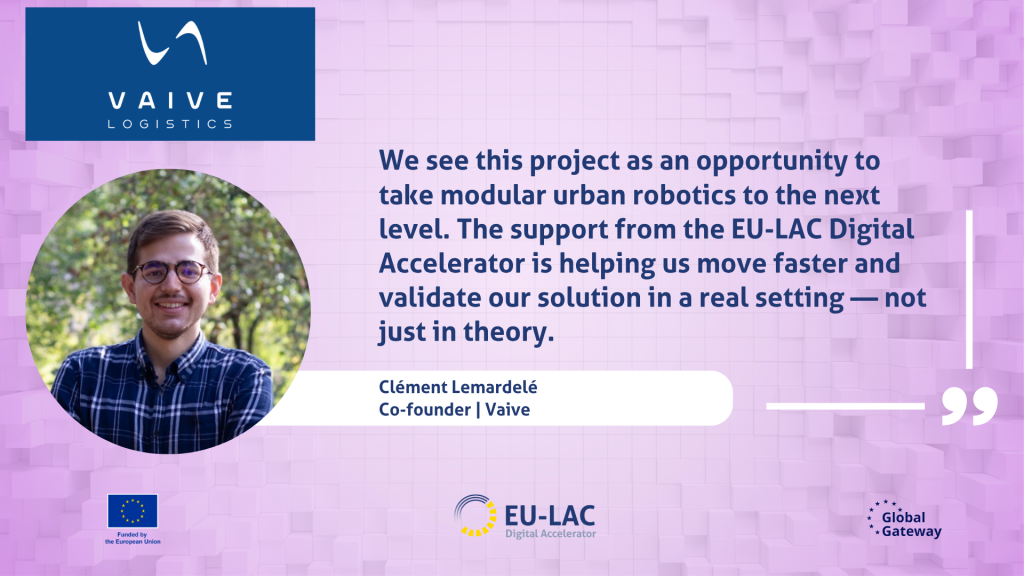In the framework of the EU-LAC Digital Accelerator, Vaive Logistics — a spin-off of the Universitat Politècnica de Catalunya – BarcelonaTech (UPC) and part of CARNET, a mobility research initiative funded by Volkswagen Group Innovation, SEAT S.A., and UPC — is partnering with Tet4D, an AI-based SaaS that automates the logistics planning. The collaboration aims to explore the potential of the integration of autonomous vehicles within Tet4D’s solution to streamline city logistics operations. Vaive will provide technical support for the integration and real-world testing of the technology within autonomous delivery use cases.
Last-mile delivery presents significant logistical challenges
In parcel shipping, the main logistical challenges typically arise in the last mile before reaching the recipient’s doorstep. Why?
- Last mile is expensive. Research shows that it accounts for 53% of overall shipping costs1.
- Time management is a complex task. Unpredictable urban conditions (traffic congestion, etc.) make it hard for logistics companies to satisfy customers.
Driven by the challenges of last-mile logistics, Vaive Logistics—an autonomous delivery robotics company based in Barcelona—was developed within the ecosystem of CARNET, a leading mobility innovation hub focused on fostering urban mobility solutions.
Ona, Vaive’s robot, operates on pedestrian pathways and is not affected by road traffic. Additionally, since Ona is electrically powered and does not need a driver, its operating expenses are comparatively low. However, these advanced logistics solutions also face significant technological challenges.
|
THE CHALLENGE How can we ensure the robot determines the most efficient route in terms of distance, time, and fuel consumption, while also accounting for real-world constraints such as traffic, delivery windows, and vehicle capacity? |
An advanced logistics planning software can cut down delivery time and CO₂ emissions
This is where Chilean startup Tet4D steps in.
The firm specialises in advanced logistics planning software, already deployed in large-scale operations across Latin America. Its solutions are known to reduce fleet size by 5–10% and cut planning time by up to 85%.
Such software goes beyond basic GPS or routing tools. It uses AI, real-time data, and predictive analytics to manage complex logistics networks to:
- Dynamically re-route deliveries
- Optimise fleets of hundreds or thousands of vehicles
- Balance workloads across depots
- Integrate with warehouse and inventory systems
In other words, it solves inefficiencies that cost time, money, and CO₂ emissions.
The goal? Integrate Tet4D’s route optimisation software in Vaive’s Ona delivery robot and test the system in real-world conditions.
Through its collaboration with Vaive and CARNET within the EU-LAC Digital Accelerator, Tet4D extends its software into the physical realm by integrating it with real-world autonomous robots. This partnership also unlocks new business opportunities in the field of autonomous delivery. Meanwhile, Vaive gains access to a practical testing environment and a concrete pathway toward commercial deployment.
An overview of the EU-LAC Digital Accelerator’s services: from roadmapping to funding
The partnership will benefit from 3 key services provided by the EU-LAC Digital Accelerator:
- Roadmapping & Strategic Alignment (IESE Business School):
The roadmapping service ensures that both companies:
– Share a clear understanding of objectives,
– Defined success through measurable KPIs,
– Agree on milestones and responsibilities.
| → How does this service help? This alignment is essential for bridging operational differences between Latin America and Europe. Moreover, by addressing scalability and risk management early on, the roadmap laid the foundation for expanding the solution to new markets. |
- Open Innovation Bootcamp (IESE Business School):
Senior innovation executives from both companies joined an intensive programme combining peer learning, expert-led workshops, and practical tools to strengthen their corporate venturing capabilities.
| → How does this service help? The bootcamp provided both companies with the tools and mindset necessary to collaborate effectively across different corporate cultures and sectors. It created a common ground for innovation and accelerated the development of trust and collaboration, which are key to a successful and agile implementation. |
- Funding Access Advisory (EBN):
The partnership team explored public and private funding channels across Europe and Latin America to support the proof of concept (PoC) and future scale-up plans. The service also delivered a tailored report and consultation session to align funding goals.
| → How does this service help? By exploring suitable public and private funding channels in both Europe and Latin America, the service enabled the team to identify pathways for sustaining the project beyond the prototype stage (product launch, industrialisation). |
A successful integration will lead to a new product and new markets
By the end of the programme, the partners expect to complete a full delivery workflow test using the Ona robot.
A full delivery workflow test involves simulating or executing the entire delivery process from start to finish using the robot and the planning software. This includes:
This test proves that all system components (digital and physical) work together in real-world conditions. |
The project will yield a working prototype, validated API integrations, and a roadmap for broader implementation.
In summary, Vaive aims to test and validate the integration of its autonomous delivery robots with Tet4D’s route optimisation software in a real logistics workflow, preparing for pilot deployments in Chile and Portugal. CARNET will assess the technology’s relevance within its broader mobility initiatives.

| You’re a corporate wanting to solve a process or product challenge? |
You’re a startup wanting to validate your solution by partnering with a corporate? |
[1] Loginext, How Autonomous Delivery Vehicles are Redefining Last Mile Delivery, <https://www.loginextsolutions.com/blog/how-autonomous-delivery-vehicles-are-redefining-last-mile-delivery/>.















